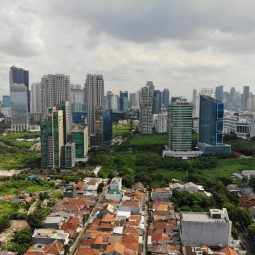Macroeconomic indicators are vital tools for analyzing a country’s economic condition. They encompass elements such as trade balance, inflation, unemployment, and economic growth rates, providing insights into the direction and overall health of the economy.
Global events significantly influence a nation’s economy. Geopolitical conflicts, major countries’ policies, or fluctuations in global oil prices can directly impact currency exchange rates. Therefore, understanding macroeconomic indicators in depth helps various stakeholders anticipate risks and seize opportunities.
To grasp the fundamental concepts of macroeconomic indicators, their relevance, and how they can effectively illuminate a country’s economic landscape, the following points are essential.
1. Gross Domestic Product (GDP)

GDP is a primary macroeconomic indicator used to measure a country’s economic performance. It reflects the total value of goods and services produced within a nation, typically calculated on a quarterly or annual basis, providing an overview of the economy’s size and health.
Key Components of GDP
GDP is calculated using three primary approaches:
- Production Approach: Measures the value added across all economic sectors, such as agriculture, industry, and services.
- Expenditure Approach: Calculates total spending, including household consumption, investment, government expenditure, and net exports (exports minus imports).
- Income Approach: Totals all earnings from production factors, such as wages, rents, interest, and profits.
Relevance of GDP in Economic Analysis
- Measuring Economic Growth: Changes in GDP over time indicate the rate of economic expansion or contraction.
- Business Planning: Companies use GDP data to understand macroeconomic conditions, influencing market demand, production costs, and investment strategies.
- Indicator of Welfare: While not comprehensive, GDP is often used as a proxy for assessing societal well-being.
Limitations of GDP
- It does not reflect income distribution or economic inequality.
- Non-market activities, like household chores or informal economies, are excluded.
- Environmental impacts of economic activities are not accounted for.
2. Unemployment Rate

The unemployment rate is an indicator that reflects labor market conditions and the efficiency of human resource utilization in an economy. Unemployment occurs when individuals who are willing and able to work cannot find employment opportunities.
A study by Ball, Leigh, and Loungani (2013) on Okun’s Law highlights the significant negative relationship between economic growth and unemployment rates. However, the impact varies across countries depending on the structure of labor markets and the level of economic development.
This research indicates that unemployment is influenced not only by economic growth but also by market dynamics, labor force shifts, technological advancements, and government policies.
Discover More: Is Global Recession Imminent?
3. Inflation Rate

The inflation rate is an indicator that measures the average change in the prices of goods and services over a specific period. Controlled inflation indicates economic stability, whereas high inflation erodes consumers’ purchasing power. Conversely, extremely low inflation (deflation) can lead to weakened demand.
This highlights that while inflation is essential for economic growth, uncontrolled inflation can cause harmful economic distortions, such as reducing consumer purchasing power and disrupting market stability.
For example, in 1998, Indonesia experienced runaway inflation due to a monetary crisis. As a result, the exchange rate of the rupiah plummeted from approximately IDR 2,500/USD to over IDR 16,000/USD, leading to a sharp increase in the prices of essential goods and imports.
4. Trade Balance

The trade balance measures the difference between the value of goods and services a country imports and exports over a specific period. A surplus indicates that the country exports more goods and services than it imports, while a deficit shows that imports exceed exports. Several factors influence the trade balance:
Trade Policies
Policies such as tariffs, export subsidies, and trade agreements directly impact exports and imports. Protective policies can safeguard domestic industries but must strike a balance to avoid trade retaliation.
Domestic Industry Competitiveness
Export capabilities are enhanced by productivity, innovation, infrastructure, and skilled labor. Competitive industries produce high-quality products at globally competitive prices.
Global Commodity Prices
Rising commodity prices benefit exporting countries like Indonesia but may disadvantage importing nations. However, the volatility of commodity prices creates economic risks, making diversification essential.
Global Economic Conditions
Global economic growth boosts exports, while recessions lower demand. Exchange rate fluctuations and international monetary policies, such as interest rates, also influence export competitiveness and import costs.
To effectively manage the trade balance, it is essential to implement balanced trade policies and develop domestic industrial sectors, ensuring that exports and imports remain in equilibrium.
5. Currency Exchange Rates

The currency exchange rate refers to the price of one currency relative to another and serves as a key indicator of economic stability and international trade performance in a country. Exchange rates impact export competitiveness, import prices, and foreign investment flows.
Thus, currency exchange rates play a critical role in international trade, inflation, and investment. To stabilize exchange rates, a country requires effective monetary policies, efficient management of foreign reserves, and robust economic resilience.
6. Interest Rates

Interest rates represent the cost of borrowing money or the return earned on investments. Expressed as a percentage, interest rates influence various economic aspects, including credit, investment, and overall economic activity.
7. Per Capita Income

Per capita income is a commonly used economic indicator to measure the economic welfare of a country. It is calculated by dividing the national income (Gross National Product, GNP) by the total population, providing the average income per individual within a country over a one-year period.
National income (GNP) represents the total earnings of all residents within a specific period, typically a year. It can be calculated using various methods, including:
- Expenditure Approach: Summing up all economic household expenditures within a specified time frame.
- Net National Income (NNI): Calculating national income after deducting indirect taxes.
Discover More: Sustainability: Definition, Examples, and Principles in Business
8. Industrial Production Index

The Industrial Production Index (IPI) is an economic indicator that measures changes in the output of various industries, including manufacturing, mining, and utilities (electricity, water, and gas) over a specific period. The IPI is also instrumental in tracking the performance of the real economy, as it significantly contributes to a country’s Gross Domestic Product (GDP).
A decline in the IPI can indicate an economic slowdown or a reduction in consumer purchasing power. Conversely, an increase in the IPI reflects higher production activity, both domestically and internationally.
9. Government Debt

Government debt refers to loans taken by a country to address economic emergencies, finance budget deficits, or support development projects. This debt can originate from domestic or international sources:
Domestic Debt
Domestic debt is acquired within the country through instruments involving domestic entities:
- Retail Government Bonds (ORI): Bonds issued by the government and sold to the general public as a way to finance the national budget.
- Bank Indonesia Certificates (SBI): Instruments issued by the central bank to manage liquidity in financial markets.
- Loans from Local Banks: The government can directly borrow funds from domestic banks to finance short-term needs or specific projects.
International Debt
International debt is the macroeconomic indicator that is acquired from foreign sources through loans or instruments involving foreign entities:
- Loans from International Financial Institutions: Funds provided by organizations like the World Bank for infrastructure projects or the International Monetary Fund (IMF) for economic stabilization.
- Global Bonds: Debt instruments issued in international markets to attract global investors, for example, global sukuk issued by the Indonesian government to finance sustainable development projects.
- Bilateral Loans: Funds borrowed from the government of another country. For example, loans from the Japanese government via the Japan International Cooperation Agency (JICA) for transportation projects like the Jakarta MRT.
10. Foreign Exchange Reserves

These macroeconomics indicator are assets held by a central bank, including foreign currencies, gold, and other liquid instruments. These reserves serve several purposes such as, stabilizing the currency value, financing international transactions, and protecting the economy from external threats such as exchange rate fluctuations and global market pressures.
Effective management of foreign exchange reserves is crucial to ensure accumulation does not exceed practical needs or miss potential investment opportunities. A stable and sufficient level of reserves reflects investor confidence in a country’s economic stability.
All these indicators are interrelated within a nation’s macroeconomic framework and collectively reflect its economic performance. A healthy trade balance, stable exchange rates, well-managed interest rates, and sufficient foreign reserves form the foundation for economic growth.
By prudently managing government debt, increasing per capita income, and promoting industrial production, governments can establish a stable, inclusive, and sustainable economic environment.
At Arghajata Consulting, we specialize in delivering actionable insights and tailored strategies to help organizations navigate complex economic landscapes. From risk management to resource optimization, we are dedicated to empowering your organization to thrive in any market condition.
[Article Reviewed and Approved by Athiya K. Maghfira/Consultant]

















